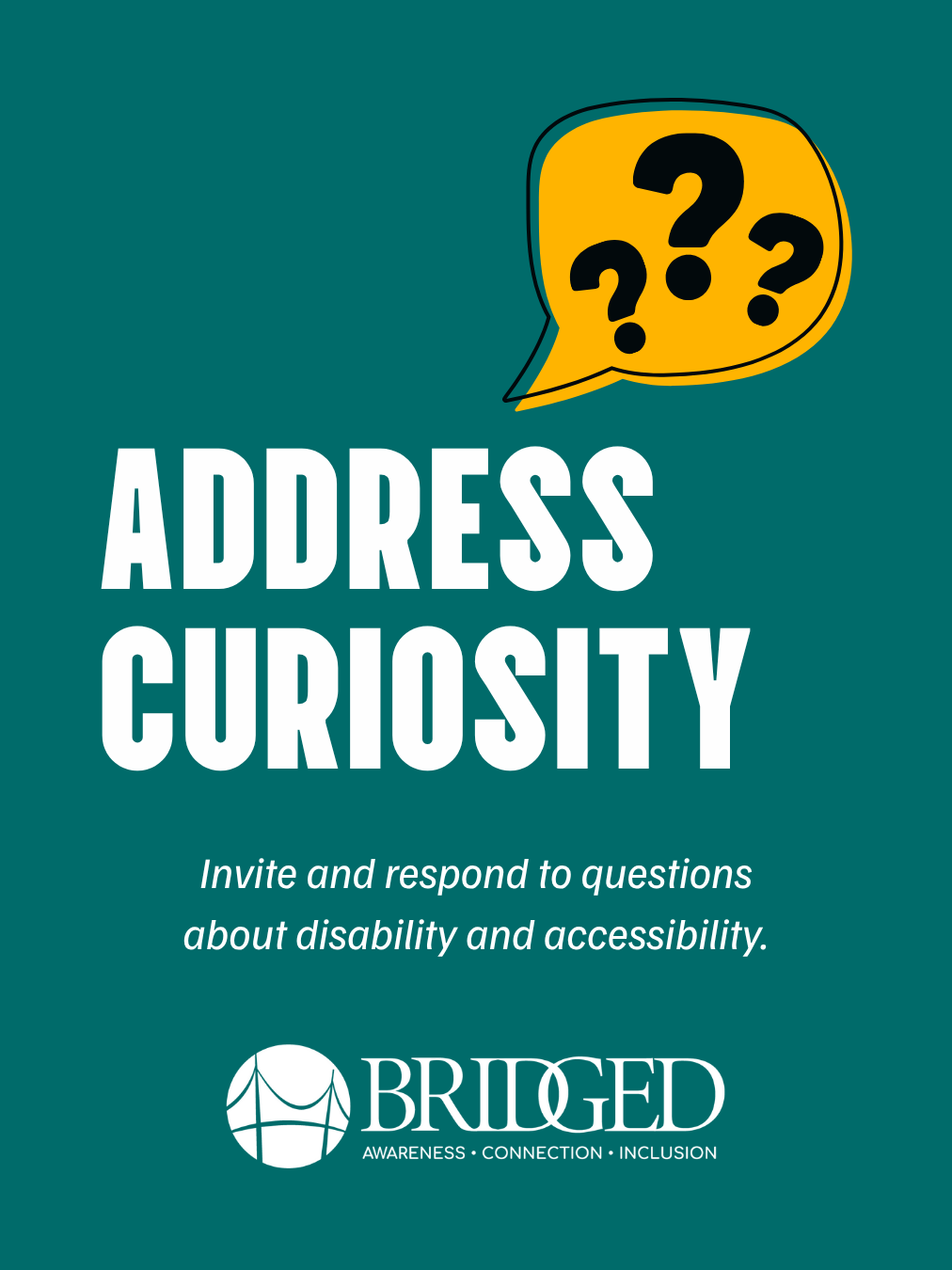ADDRESS CURIOUSITY & RESPOND TO QUESTIONS
PART THREE OF OUR LEAD THE CONVERSATION ABOUT DISABILITY WITH CONFIDENCE SERIES
We are continuing our blog series on how to LEAD the conversation about disability with confidence.
As a reminder, here’s what LEAD stands for:
🌱 L = Learn Together
💛 E = Encourage Empathy
❓ A = Address Curiosity
💬 D = Define & Embrace
If you missed the first two posts, you can find them here:
Today, we’re diving into A = Address Curiosity — an important (and often overlooked) part of talking to kids about disability.
WHAT IT MEANS TO “ADDRESS CURIOSITY”
Children are naturally curious. They ask questions because they’re trying to make sense of the world around them — and that’s a good thing!
But sometimes, their questions come at unexpected times or in public spaces. You’ve probably been there — your child points and asks, “Why is that person in a wheelchair?” or “Why does she talk like that?” Your first instinct might be to hush them.
Take a deep breath — and please resist that urge!
When we hush curiosity, we unintentionally send the message that disability is something to avoid or be embarrassed about.
When we address curiosity, we teach that disability is a normal, natural part of human diversity — something we can learn about and discuss respectfully.
HOW TO ADDRESS CURIOSITY IN HEALTHY, RESPECTFUL WAYS
1. Stay Calm
Kids take their cues from you. If you respond with calm confidence, they’ll learn that disability is a comfortable topic to discuss. This will reduce an unwarranted fear and decrease false stereotypes.
Sample Scripts:
“That’s a great question. Let’s talk about it together.”
“They’re using a wheelchair to get around. Isn’t it cool how there are so many ways for people to move?”
“I’m not sure, but let’s look it up when we get home.”
✨ Tip: If you don’t know the answer, say so!
2. Use Your Surroundings as Teaching Moments
Everyday environments are full of opportunities to talk about disability and accessibility. By inviting your kids to notice accessibility in the world around them, you’re teaching them that inclusion doesn’t happen by accident — it happens by design.
Sample Script:
“Have you ever wondered why sidewalks have little ramps at the ends? Those help people using wheelchairs, walkers and strollers.”
“See that parking space with the blue sign? That’s a reserved spot for people who need to park close to the entrance.”
“This restaurant has braille menus and a hearing symbol. That means they’ve thought about how to include everyone!”
“Why do you think this store has wider doors and lower counters?”
“Accessibility — like ramps, captions, or flexible learning — helps remove barriers so everyone has the same opportunities.”
✨ Tip: While you encourage opportunities to learn, make sure to avoid pity. We’re raising observers, not spectators.
3. Encourage Respectful Curiosity
It’s normal for kids to look — that’s part of learning. What matters is how you respond.
Sample Script:
“It’s okay to notice differences, but let’s not point.”
“Everyone’s body works differently. Some people use devices or tools to help them do things.”
“People with disabilities aren’t scary or fragile — they’re just people who may do things in their own way.”
✨ Tip: Avoid shaming your child for noticing or asking. Redirect their curiosity into conversation.
4. Normalize Asking Questions — Even When You Don’t Have the Perfect Answer
Adults often think they need a “perfect script,” but what kids really need is permission or an invitation to ask.
Sample Script:
“That’s a really good question — I’m glad you noticed.”
“I don’t have all the answers, but we can learn more about it together.”
“It’s okay to be curious. We just ask questions in a kind and respectful way.”
✨ Tip: Curiosity is great — when it’s kind and respectful. However, we want to encourage kids to avoid questions like “What’s wrong with you?” or “Why do you use a wheelchair?” or expect someone to explain their disability. It’s important to listen to people with disabilities, but we shouldn’t pressure them to share personal information unless they offer.
💬 CLOSING THOUGHTS
Every child notices differences. Penn State conducted a study and found that by age three, children notice physical disabilities. But, by age four to five, kids can become fearful of differences. If we don’t talk about disability, kids often fill in the blanks themselves, which can lead to confusion, fear or stereotypes.
The way we, as adults, talk about disability can make all the difference.
When you Address Curiosity with calm, confident, and respectful answers, you’re teaching your children that disability isn’t something to avoid — it’s something to understand and celebrate.
✨ Remember: Disability is a natural part of human diversity. When we talk about it openly, we create a culture of inclusion.
Next time, we’ll wrap up our LEAD series with the final step — D = Define & Embrace — where we’ll talk about how to explain disability simply and help kids see differences as part of what makes our world beautiful.
At BRIDGED, we are passionate about disability education. In addition to supporting conversations about disability at home, we also support conversations at school through our award-winning Disability Awareness Programs. Our school-based programming cultivates a disability-inclusive environment through education and experience. Programming is available for K-12 students in both public and private schools. You can learn more by clicking here.

